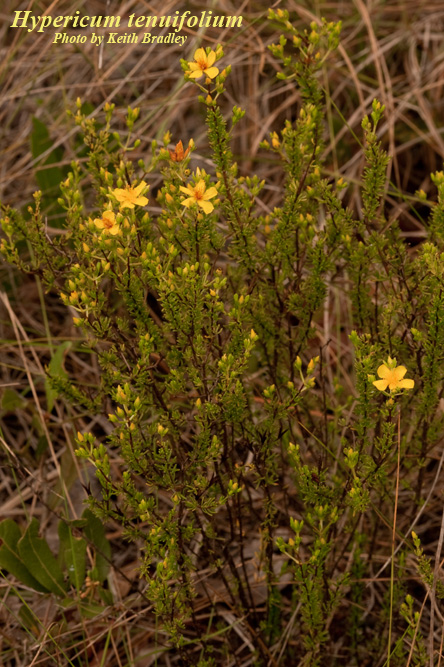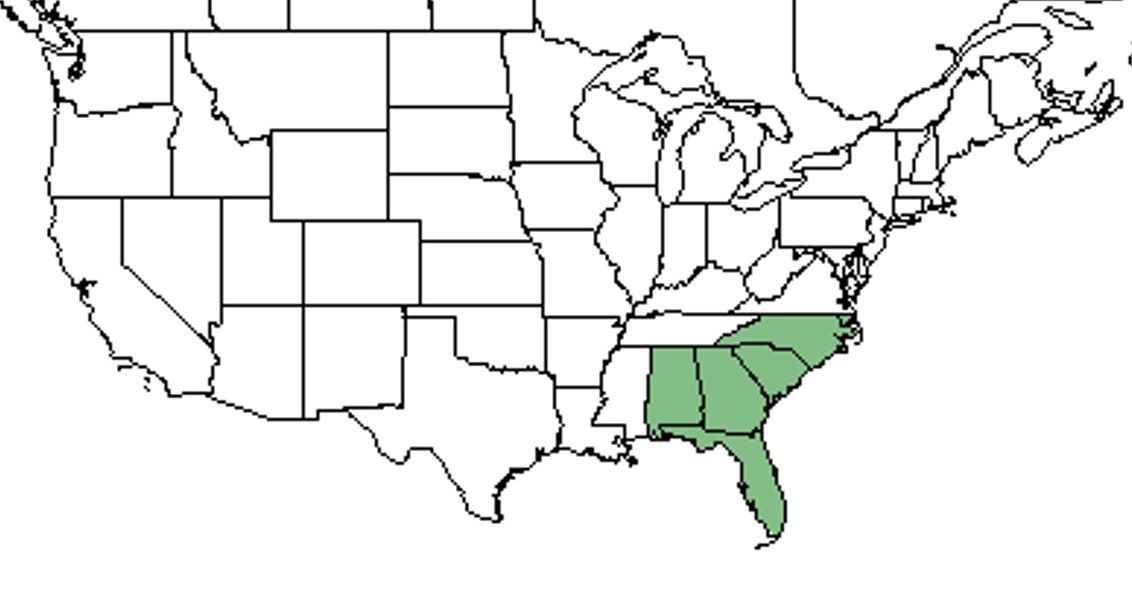Hypericum tenuifolium
| Hypericum tenuifolium | |
|---|---|

| |
| Photo by Keith Bradley, Atlas of Florida Vascular Plants | |
| Scientific classification | |
| Kingdom: | Plantae |
| Division: | Magnoliophyta - Flowering plants |
| Class: | Magnoliopsida - Dicotyledons |
| Order: | Theales |
| Family: | Clusiaceae ⁄ Guttiferae |
| Genus: | Hypericum |
| Species: | H. tenuifolium |
| Binomial name | |
| Hypericum tenuifolium Pursh | |

| |
| Natural range of Hypericum tenuifolium from USDA NRCS Plants Database. | |
Common name: Atlantic St. John's-wort; Sandhill St. John's-wort[1]
Contents
Taxonomic notes
Synonyms: Hypericum reductum (Svenson) W.P. Adams; H. aspalathoides Willdenow.[1]
Varieties: none.[1]
Description
H. tenuifolium is a short-lived perennial herb that can reach heights of 12 to 18 inches. Stems are reddish-brown and are covered with short needle-like shiny, deep-green leaves.[2] The flowers have 5 yellow petals, 5 persistent sepals, a superior ovary, and are bisexual and radially symmetrical.[3] A distinctive characteristic of this species is a long seed capsule, ranging from 6 to 9 mm long.[4]
“Usually glabrous herbs or shrubs. Leaves usually punctate, simple, opposite, entire, usually sessile or subsessile, exstipulate. Inflorescence basically cymose; flowers perfect, regular, bracteates, subsessile or short-pedicellate, sepals 2, 4, or 5, persistent; petals 4 or 5, usually marcescent, yellow or pink; stamens 5-numerous, separate or connate basally forming 3-5 clusters or fascicles, filaments usually persistent; carpels 2-5, stigmas and styles separate or fused, ovary superior, 1-locular or partly or wholly 2-5 locular, placentation axile or parietal. Capsules basically ovoid, longitudinally dehiscent, styles usually persistent; seeds numerous, lustrous, areolate, cylindric, or oblong. In general, our species form a polymorphic complex with many intergrading taxa.”[5]
"Decumbent, matted shrub, 1-5 dm tall, stems usually angled. Leaves linear-subulate, the largest 5-13 mm long, 0.5-1 mm wide, acute, slightly revolute, base notched, sessile. Cymules or dichasia terminal and axillary, or flower solitary, axillary. Sepals 5, similar to leaves, usually less than4.5 mm long; petals 5, 4-10 mm long; styles 3, united or usually separate in fruit, 0.8-3 mm long, ovary 3-locular. Capsules subcylindric, 6-9 mm long, 1.5-2 mm broad; seeds blackish, ca. 0.5 mm long."[5]
Distribution
This plant occurs from southeastern North Carolina to southern peninsular Florida, as well as throughout the Florida Panhandle and southeastern Alabama.[1]
Ecology
Habitat
This species is found in dry, sandy, open sites with good drainage such as sandy woods, dunes and dune hollows, lowland, and coastal areas.[6] It is drought tolerant, however, it does not favor well in soils that remain wet for extended periods.[2] Associated species include Polygonella polygama, Pinus palustris, and Paronychia chartacea.[7]
Phenology
Flowering occurs during late spring and early summer with more than a dozen flowers open at any time.[2] Flowers are yellow and aromatic with the fruit capsule ranging from 6 to 9 mm in length.[4]
Pollination
Various species were observed to visit the flowers of Hypericum tenuifolium at the Archbold Biological Station. These species include long-tongued bees from the Apidae family (Apis mellifera, Bombus griseocollis and B. impatiens), plasterer bees from the Colletidae family (Colletes distinctus, C. productus and Hylaeus confluens), sweat bees from the Halictidae family (Augochlorella aurata, A. gratiosa, Augochloropsis anonyma, A. metallica, A. sumptuosa, Lasioglossum miniatulus, L. nymphalis, L. placidensis and L. tamiamensis), and leafcutting bees from the Megachilidae family (Anthidiellum perplexum, Dianthidium floridiense, Megachile albitarsis, M. brevis pseudobrevis and M. rugifrons).[8]
Conservation, cultivation, and restoration
Cultural use
Photo Gallery
References and notes
- ↑ 1.0 1.1 1.2 1.3 Weakley, A.S. 2015. Flora of the southern and mid-atlantic states. Working Draft of 21 May 2015. University of North Carolina at Chapel Hill, Chapel Hill, North Carolina.
- ↑ 2.0 2.1 2.2 [[1]]UGA Extension Accessed: January 6, 2016
- ↑ [[2]] Name that Plant. Accessed: January 6, 2016
- ↑ 4.0 4.1 [[3]] Accessed: January 6, 2016
- ↑ 5.0 5.1 Radford, Albert E., Harry E. Ahles, and C. Ritchie Bell. Manual of the Vascular Flora of the Carolinas. 1964, 1968. The University of North Carolina Press. 709-712. Print.
- ↑ [[4]] Hypericum online. Accessed: January 6, 2016
- ↑ Florida State University Robert K. Godfrey Herbarium database. URL: http://herbarium.bio.fsu.edu. Last accessed: October 2015. Collectors: Loran C. Anderson, Wilson Baker, Ann Johnson. States and Counties: Florida: Bay. Compiled by Tall Timbers Research Station and Land Conservancy.
- ↑ Deyrup, M.A. and N.D. 2015. Database of observations of Hymenoptera visitations to flowers of plants on Archbold Biological Station, Florida, USA.